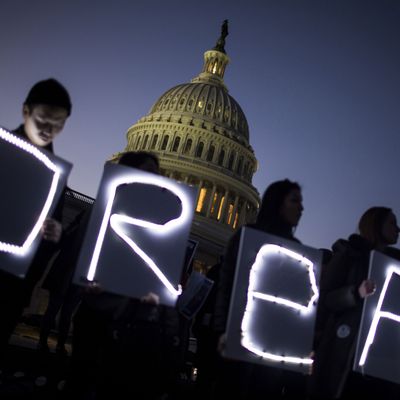
There’s a lot of political posturing we will still have to go through before an end to the partial government shutdown can occur. Most fundamentally, President Trump must be sure he has put out the fire on his right flank that roared into view when it looked like he was going to back off on a border-wall-funding demand in exchange for signing an appropriations bill. That means something that he can construe as a concession on the wall must be wrung from Democratic congressional leaders who are publicly adamant about denying him exactly that. Democrats certainly won’t make any moves away from that position until the House has passed Nancy Pelosi’s bill, which extends Homeland Security funding into next month without wall funding and releases the rest of the federal government from the whole dispute.
Beyond the next few moves on the checkerboard (which presumably includes Trump’s condescending invitation to congressional leaders to a “briefing” from his DHS officials on the need for a border wall), any resolution will depend on each side’s perception of the political fallout from a continued impasse. The conventional wisdom is that the shutdown is hurting Trump and his party. So long as he disagrees, he has no strong incentive for backing down, particularly since truly hard-core conservatives like government shutdowns as ends in themselves.
If and when both parties decide that ending the shutdown on some mutually agreeable terms is a good idea, they have to devise a deal that offers such terms. And there are really only two readily available options: (1) a splitting-the-baby compromise on funding levels for border security accompanied by some Jesuitical language on border barriers that allows both sides to claim they didn’t lose on the principle of the wall; or (2) a return to the much-discussed dynamics of a larger deal that would give Trump wall funding in exchange for immigration concessions, notably an end to the limbo Dreamers were placed in via Trump’s efforts to end their protections under Obama’s DACA program.
A DACA-for-Wall deal has been on (or near) the table during immigration talks for well over a year. It probably came closest to fruition in February of 2018, when a bipartisan group of senators devised a proposal — but the White House shot it down, as CNN reported at the time:
A much-anticipated bipartisan deal that would have paired a pathway to citizenship for nearly 2 million undocumented immigrants who came to the US as children with $25 billion in border security and some other measures failed to get the 60 votes necessary to advance legislation after furious White House opposition …
The episode, coming at the end of a much-anticipated Senate week of debate on immigration, revealed that the White House was able to kill momentum for a deal that had emerged out of weeks of talks by roughly 20 bipartisan senators – but that it also had no ability to enact any legislation to achieve its stated goal of protecting the recipients of the Deferred Action for Childhood Arrivals program, which President Donald Trump is ending, and increasing border security measures along with it.
One problem is that a straightforward DACA-for-Wall deal has been considerably complicated by Trump adviser Stephen Miller’s obsession with securing restrictions on legal immigration as a condition for any Dreamer relief. Indeed, the February 2018 bipartisan proposal had some provisions reflecting administration demands for reductions in “lottery” visas and family-based immigration sponsorships. But the White House kept moving the goalposts, and now it seems hell-bent on restrictions on refugees as well as on other immigrants who seek legally provided entry.
For his part, Trump keeps claiming that Democrats don’t care enough about Dreamers to give him what he wants in exchange for ending the torment he has inflicted on them. Just last week, Trump raised the subject again on Twitter:
Trump’s revisionist history aside, someone has to explicitly offer a DACA-for-Wall deal before real negotiations can resume, and Lindsey Graham has now stepped up:
Republican Sen. Lindsey Graham of South Carolina urged the White House and Democrats to consider supporting what he called a “breakthrough” compromise on immigration that would allow President Trump to secure his $5 billion demand for border security funds and also codify protections for Deferred Action for Childhood Arrivals (DACA) and Temporary Protected Status (TPS) holders.
“I don’t see Democrats giving us more money, unless they get something,” Graham told reporters outside the White House Sunday afternoon after a two-hour lunch with the president.
Graham said he proposed the idea to Mr. Trump, who he said called it “interesting.” He said the deal would entail the White House supporting the Bridge Act, a bill Graham co-sponsored to grant DACA recipients three-year work permits, as well as legislation to extend the legal status of TPS holders. In exchange, Democrats would need to support a spending measure that includes $5 billion in funding for border security.
It’s clear, however, that congressional Democrats aren’t going to start making positive noises about such a deal until such time as Trump embraces it, given his long history of flip-flopping on DACA in particular. And they may also decide that Graham’s temporary DACA extension is no substitute for the path to citizenship for Dreamers that Trump — in principle, at least — has intermittently supported.
So while there’s no reason to expect any quick breakthrough, the basic elements are there for a deal that would not only end the partial government shutdown, but take immigration policy off the front burner of political conversation for a good while. And it’s this last possibility that Trump and Stephen Miller may find unacceptable.






























